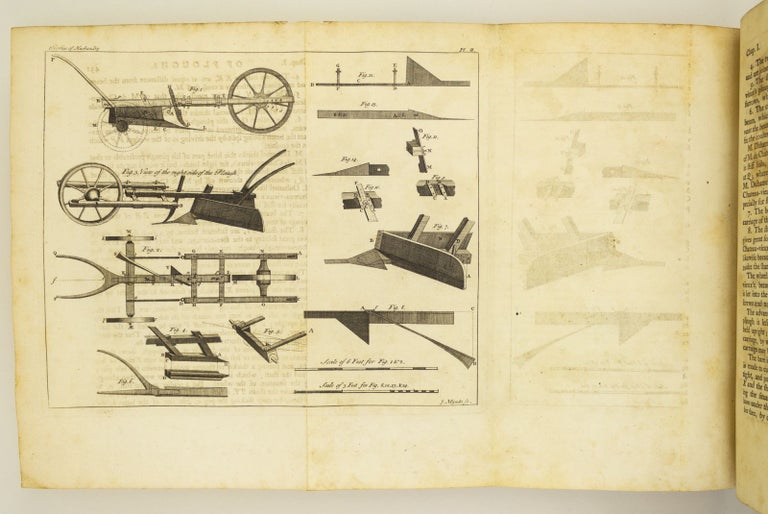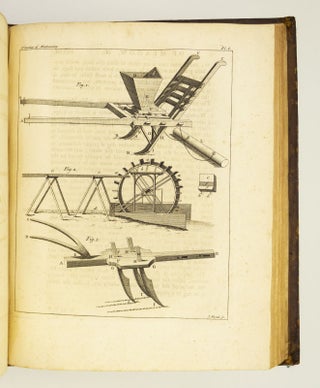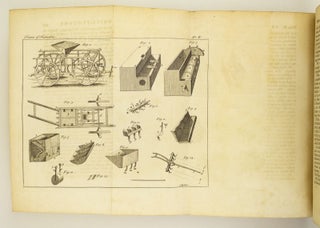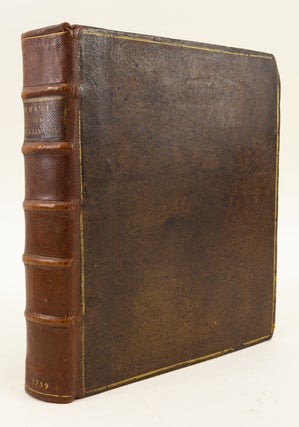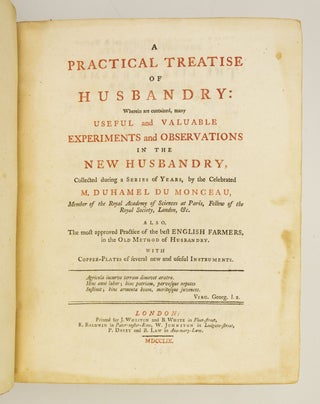A PRACTICAL TREATISE OF HUSBANDRY.
(London: Printed for J. Whiston and B. White, 1759). 268 x 210 mm. (10 1/2 x 8 1/4"). xxiv, 491, [9] pp. (the last ads). Translated and edited by John Mills. First Edition in English.
Contemporary sprinkled calf, raised bands, rebacked with brown morocco, original tan morocco title label (restorations to corners). With a folding diagram for barley planting, and six copper engravings of farm equipment (ploughs, seed drills, etc.), four of them folding. Front pastedown with armorial bookplate of Sir George Shuckburgh, Bart., and ex-libris of Rachel McMasters Miller Hunt. Fussell II, 48-49; Hunt 564 (this copy). ◆Extremities a bit rubbed, corners bumped, but A FINE COPY INTERNALLY, quite clean, fresh, and wide margined, in a solid, serviceable binding.
This is the Hunt copy of an influential work by the French polymath whom Raphael calls "one of the outstanding botanists of the 18th century" in the fields of plant physiology and agriculture. A physician, naval engineer, and botanist, Henri-Louis Duhamel du Monceau (1700-82) gave up on formal university training to take lodgings near the Botanical Gardens, where he pursued his own plan of learning from the director and from other distinguished persons who gathered there. After inheriting his father's estate, he set up a model farm on the property to test various theories and methods of agriculture. According to Fussell, Duhamel was a proponent of Jethro Tull's "drill husbandry" method of cultivating seeds planted in rows by machine, the technique that formed the basis of modern agricultural practice. "He carried out extensive and probably costly experiments and demonstrated the financial advantages and increased physical volume of yield the system provided. This book no doubt played a large part in stimulating interest in the drill husbandry." Hunt notes that the present work was "apparently collected from several publications by Duhamel . . . with the addition of observations and experiments by other French and English writers" by translator and editor John Mills, (ca. 1717 - ca. 1794). The present item was once owned by one of the greatest botanical book collectors of modern times, Rachel McMasters Miller Hunt (1882-1963). According to the Hunt Institute website, "at the age of 15, Rachel received her first rare book, Leonard Meager's 'The English Gardener' (1670), from a family member. Given her interest in plants, gardens, books and history, this book planted the seed[!] for a lifelong appreciation of reading and collecting books about botany, gardens and other plant-related topics." In addition to assembling an outstanding book collection, Hunt was a respected bookbinder who studied with Cobden-Sanderson's pupil Euphemia Bakewell and operated the Lehcar (Rachel spelled backwards) Bindery out of her family home. She was a founding member of the Hroswitha Club for women bibliophiles, which has since merged with the formerly all-male Grolier Club. Another previous owner, Sir George Shuckburgh, sixth baronet (1751-1804), was a prominent mathematician who was awarded the Royal Society's Copley Medal for his work to establish the standard length of a yard. (ST15736e)
Price: $1,900.00

